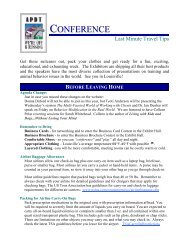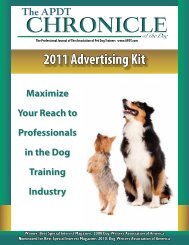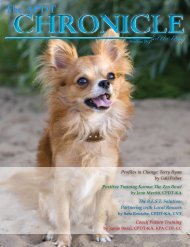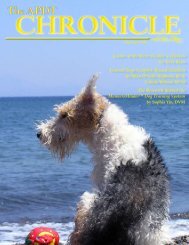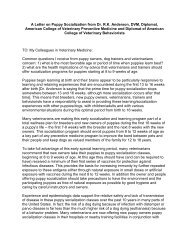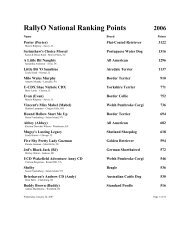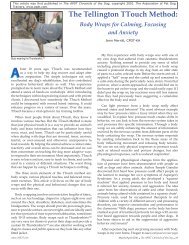of the Dog - Association of Pet Dog Trainers
of the Dog - Association of Pet Dog Trainers
of the Dog - Association of Pet Dog Trainers
Create successful ePaper yourself
Turn your PDF publications into a flip-book with our unique Google optimized e-Paper software.
plus o<strong>the</strong>r species evinced a message pattern closer to <strong>the</strong><br />
category average. Based on <strong>the</strong>se results, canine signals<br />
may be influenced by living with non-canine animals and<br />
this effect may prove a fascinating future research topic!<br />
Owners and <strong>Trainers</strong><br />
The majority <strong>of</strong> respondents owned dogs for at least<br />
four years and identified <strong>the</strong>mselves as trainers with more<br />
than 70% working part-time. About half <strong>the</strong> respondents<br />
noted additional experience with dogs such as veterinary<br />
technician, pr<strong>of</strong>essional groomer or sitter, animal welfare<br />
volunteer, as well as handler for <strong>the</strong>rapy work and<br />
ring sports. A dozen participants failed to list type <strong>of</strong><br />
ownership.<br />
New owners (three or less years) cited vocal and gesture<br />
more than any o<strong>the</strong>r behavior and well above average, an<br />
expected response as humans innately attune to verbal<br />
and nonverbal language. 20 Experienced owners tracked<br />
close to average while those with unknown background<br />
listed more modeling, complex and touch and considerably<br />
less gesture than average. The majority <strong>of</strong> new owners<br />
thought <strong>the</strong>ir pets craved attention but (a surprise) no play,<br />
affection, alert or potty messages (why accidents happen?).<br />
Experienced owners noticed much less attention seeking<br />
but slightly above average play, alert, greet and avoidance<br />
messages. For <strong>the</strong>m, affection also dipped below average.<br />
Those with unknown background saw potty, request<br />
and affection messages equally and higher than average<br />
permission.<br />
Full-time trainers’ acumen for canine nuance showed.<br />
They reported considerably less vocal and action behaviors<br />
but more complicated modeling and complex behaviors<br />
which scored nearly three times <strong>the</strong> average. Full-time<br />
trainers noted higher than average gestures. Full-time<br />
trainers’ canines <strong>of</strong>fered no permission, avoidance, beg or<br />
play messages. Their dogs sought both attention and o<strong>the</strong>r<br />
requests in one-third <strong>of</strong> <strong>the</strong>ir messages. And, <strong>the</strong>ir dogs<br />
showed affection and greet slightly above average.<br />
Part-time trainers proved more interesting. The vocal<br />
responses topped <strong>the</strong> average and almost equaled that <strong>of</strong><br />
new owners. They also reported less than average gestures<br />
and modeling but higher touch and gaze. A reason may be<br />
that some experienced owners or o<strong>the</strong>rs such as shelter<br />
volunteers considered <strong>the</strong>mselves part-time trainers<br />
although <strong>the</strong>y lacked requisite knowledge and experience.<br />
However, those mentioning “additional” experience<br />
scored close to average. Part-time trainers’ dogs seem a<br />
bit less mannered than those <strong>of</strong> <strong>the</strong>ir full-time peers. Parttimers<br />
reported <strong>the</strong>ir pets <strong>of</strong>fered avoidance, beg, permission,<br />
affection messages equal to average but fewer attention<br />
appeals. Their pups also asked to potty more than <strong>the</strong> <strong>the</strong>ir<br />
peers and for higher than average general requests<br />
At least three part-time trainers may have misidentified<br />
calming signals as ano<strong>the</strong>r message. One said <strong>the</strong> dog’s<br />
tongue flick and sneeze marked impatience with a<br />
training lull (instead <strong>of</strong> insecurity with <strong>the</strong> training<br />
itself?). Ano<strong>the</strong>r owner viewed yawns as a potty request or<br />
beg, while <strong>the</strong> o<strong>the</strong>r correctly noted <strong>the</strong> dog’s tongue flicks<br />
www.APDT.com<br />
as likely avoidance.<br />
Class Attendance<br />
A majority <strong>of</strong> respondents ei<strong>the</strong>r graduated from<br />
(39%) or were currently enrolled (18%) in a dog training<br />
class; <strong>the</strong> rest did not specify any class participation.<br />
Current students reported six times <strong>the</strong> action behaviors<br />
<strong>of</strong> graduates, but slightly less vocal behaviors than grads or<br />
<strong>the</strong> mean. A note to trainers, your classes help—<strong>the</strong> current<br />
students, who most likely are new owners, reported almost<br />
half <strong>the</strong> vocal communications <strong>of</strong> general new owners and<br />
reported more action, complex and gaze behaviors. Current<br />
students, though, indicated much less modeling and<br />
gestures than newbies, graduates or non-students. Grads<br />
tracked closely to both <strong>the</strong> baseline and <strong>the</strong> responses <strong>of</strong><br />
experienced owners. Non-students listed <strong>the</strong> most vocal<br />
and modeling behaviors but fewer gaze or gesture behaviors<br />
than <strong>the</strong> student groups or average.<br />
Current students interpreted <strong>the</strong> most attention<br />
messages, but far less than <strong>the</strong> 60% identified by general<br />
new owners. Current students also led in play and affection<br />
messages, both twice <strong>the</strong> average, and in permission. Nonstudents<br />
tracked highest in avoidance. Grads noted double<br />
permission seeking than ei<strong>the</strong>r <strong>the</strong> average or experienced<br />
owners, perhaps due to insights gained during classes.<br />
O<strong>the</strong>r Activities<br />
Our respondent-dog teams participated in 10 different<br />
activities with agility <strong>the</strong> most popular followed by<br />
obedience, conformation, and <strong>the</strong>rapy. Herding and Rally<br />
sports teams reported <strong>the</strong> most complicated behaviors<br />
with herders five times <strong>the</strong> average for complex and Rally<br />
four times <strong>the</strong> average modeling scores. Herders also ranked<br />
highest in action and led in alert messages with show and<br />
<strong>the</strong>rapy dogs next. Herders sought play four times more<br />
than average followed by SAR dogs, who, surprisingly,<br />
ranked well over average for avoidance. Show dogs also<br />
ranked above baseline for avoidance and beg. Show and<br />
herder dogs asked for potty breaks most <strong>of</strong>ten.<br />
Therapy dogs obviously showed <strong>the</strong> highest affection<br />
messages (followed by obedience) but, ironically, gave<br />
<strong>the</strong> most vocal behaviors, a reaction <strong>the</strong>y should not <strong>of</strong>fer<br />
during visits. SAR and Rally activities also produced very<br />
high vocal scores. Agility and <strong>the</strong>rapy dogs also gestured<br />
most <strong>of</strong>ten with conformation and agility tied for second.<br />
Service dogs had very above average rates for touch and<br />
gaze behaviors as well as permission messages. Rally led in<br />
attention with obedience and agility close behind.<br />
Interesting Examples<br />
If, as Marc Bek<strong>of</strong>f asserts, “anecdotes are data,” 21 <strong>the</strong>n<br />
<strong>the</strong> stories related by participants in <strong>the</strong>ir essay responses<br />
may reveal more about canines creative communications<br />
than any statistical data.<br />
Complicated complex and modeling behaviors produced<br />
imaginative, non-trained communiqués. One Collie<br />
imitated humans by ringing a [continued on next page]<br />
November/December 2008 w The APDT Chronicle <strong>of</strong> <strong>the</strong> <strong>Dog</strong> w 29<br />
Creative Canine: Original Intentional Canine-to-Human Communication



